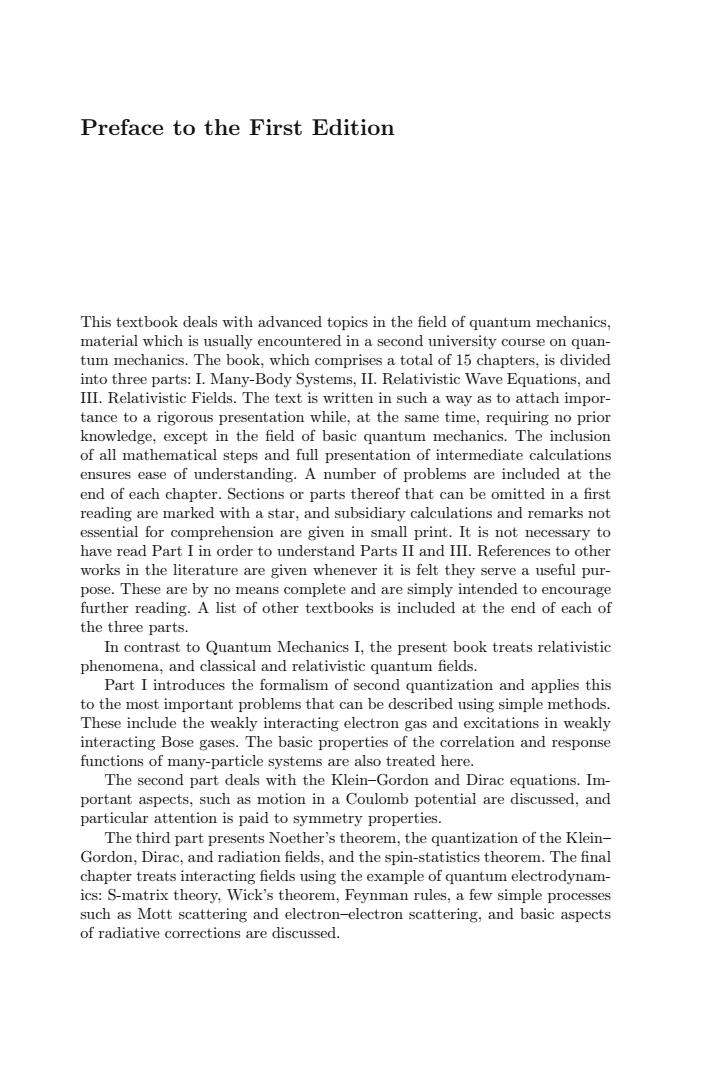正在加载图片...

Preface to the First Edition This textbook deals with advanced topics in the field of quantum mechanics mater whichissnda ondpi tum mechanic. into three parts:I -Body Systems,II.Relat vistic Wave Equations,and III.Relativistic Fields.The text is written in such a way as to attach impor tance to a rigorous presentation while,at the same time,requiring no prior knowledge,except in the field of basic quantum mechanics.The inclusion of all mathematical steps and full presentation of intermediate calculations ensures ease of understanding.A number of problems are included at the end of each chapter Sections or parts thereof that can be omitted in a first emarked with a star,a nd subsidia emarks sma pri It is not necessary have read P works in the literature are given whenever it is felt they serve a useful pur pose.These are by no means complete and are simply intended to encourage further reading.A list of other textbooks is included at the end of each of the three parts. In contrast to Quantum Mechanics I.the present book treats relativistic phenomena,and classical and relativistic quantum fields. Part Iin oduces the forr of s ems that nd quntization and a applies this t can be e described using s mple methods These incl tron ga sand excit in weakly interacting Bose gases.The basic properties of the correlation and response functions of many-particle systems are also treated here. The second part deals with the Klein-Gordon and Dirac equations.Im- portant aspects,such as motion in a Coulomb potential are discussed,and particular attention is paid to symmetry properties. The third part presents Noether's theorem,the quantization of the Klein- Gordon Dira and adiatio n fields,and the tatistics the n.The final interac rix theory, heorem,Feynman rules,a few simple proces scattering and scattering,and basic aspects of radiative corrections are discussed Preface to the First Edition This textbook deals with advanced topics in the field of quantum mechanics, material which is usually encountered in a second university course on quantum mechanics. The book, which comprises a total of 15 chapters, is divided into three parts: I. Many-Body Systems, II. Relativistic Wave Equations, and III. Relativistic Fields. The text is written in such a way as to attach importance to a rigorous presentation while, at the same time, requiring no prior knowledge, except in the field of basic quantum mechanics. The inclusion of all mathematical steps and full presentation of intermediate calculations ensures ease of understanding. A number of problems are included at the end of each chapter. Sections or parts thereof that can be omitted in a first reading are marked with a star, and subsidiary calculations and remarks not essential for comprehension are given in small print. It is not necessary to have read Part I in order to understand Parts II and III. References to other works in the literature are given whenever it is felt they serve a useful purpose. These are by no means complete and are simply intended to encourage further reading. A list of other textbooks is included at the end of each of the three parts. In contrast to Quantum Mechanics I, the present book treats relativistic phenomena, and classical and relativistic quantum fields. Part I introduces the formalism of second quantization and applies this to the most important problems that can be described using simple methods. These include the weakly interacting electron gas and excitations in weakly interacting Bose gases. The basic properties of the correlation and response functions of many-particle systems are also treated here. The second part deals with the Klein–Gordon and Dirac equations. Important aspects, such as motion in a Coulomb potential are discussed, and particular attention is paid to symmetry properties. The third part presents Noether’s theorem, the quantization of the Klein– Gordon, Dirac, and radiation fields, and the spin-statistics theorem. The final chapter treats interacting fields using the example of quantum electrodynamics: S-matrix theory, Wick’s theorem, Feynman rules, a few simple processes such as Mott scattering and electron–electron scattering, and basic aspects of radiative corrections are discussed